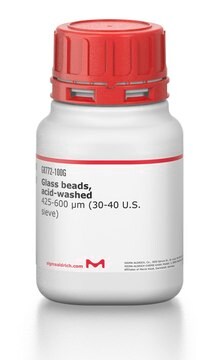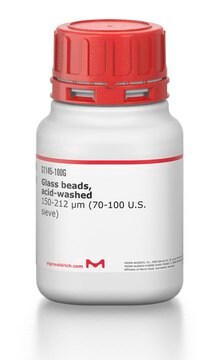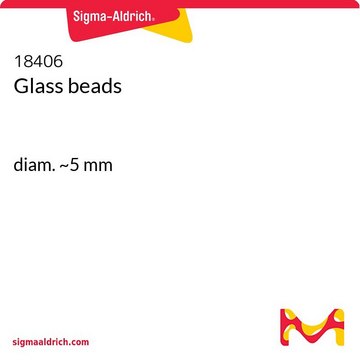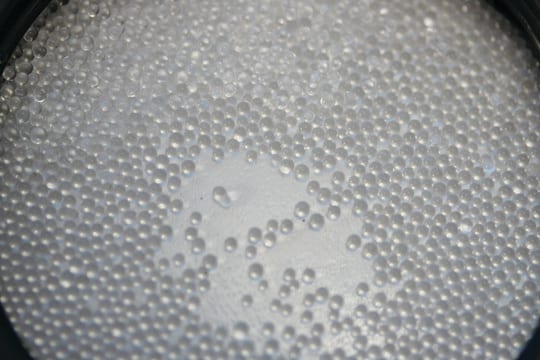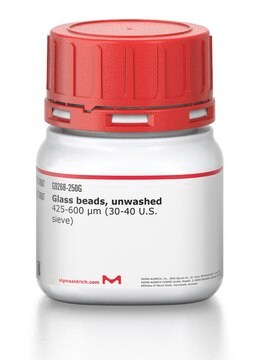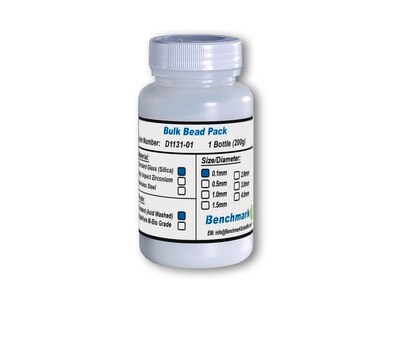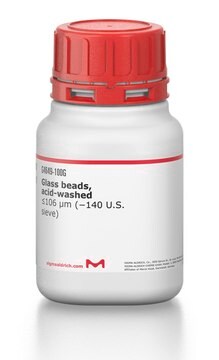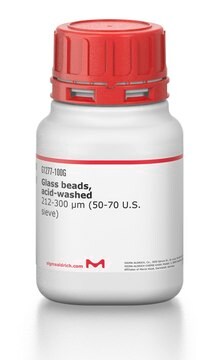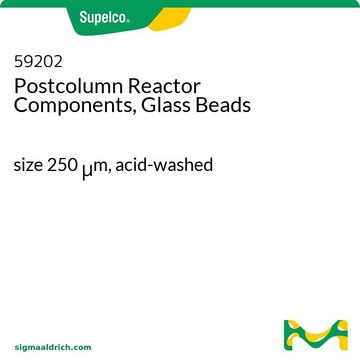Z250465
Glass beads
diam. 0.5 mm, for Mini-Beadbeater
Faça loginpara ver os preços organizacionais e de contrato
About This Item
Código UNSPSC:
12000000
NACRES:
SB.32
Produtos recomendados
Diâmetro
0.5 mm
Procurando produtos similares? Visita Guia de comparação de produtos
Descrição geral
Glass has a density of 2.5 g/cc and is the most commonly used bead media for ′Beadbeating′. Beads are sold in one pound bottles.
Aplicação
- Extraction of Diatom DNA from Water Samples and Tissues.: This study details a method for extracting DNA from diatom samples using glass beads to enhance the mechanical disruption of cell walls, facilitating the efficient recovery of high-quality DNA for downstream applications (Zhou YC et al., 2023).
- Combination of direct boiling and glass beads increases the purity and accuracy of bacterial DNA extraction.: The research presents an improved bacterial DNA extraction technique combining direct boiling with glass beads, resulting in higher purity and accuracy of the extracted DNA, which is crucial for precise molecular analyses (Li S et al., 2023).
- Solvent Precipitation SP3 (SP4) Enhances Recovery for Proteomics Sample Preparation without Magnetic Beads.: The study explores the use of solvent precipitation SP3 with glass beads, offering an efficient alternative for proteomics sample preparation, yielding better protein recovery compared to magnetic beads (Johnston HE et al., 2022).
- Efficient isolation of brain capillary from a single frozen mouse brain for protein expression analysis.: This research demonstrates an optimized method for isolating brain capillaries from frozen mouse brains using glass beads, enabling detailed protein expression analysis critical for neuroscience research (Ogata S et al., 2021).
Escolha uma das versões mais recentes:
Certificados de análise (COA)
Lot/Batch Number
It looks like we've run into a problem, but you can still download Certificates of Analysis from our Documentos section.
Se precisar de ajuda, entre em contato Atendimento ao cliente
Já possui este produto?
Encontre a documentação dos produtos que você adquiriu recentemente na biblioteca de documentos.
Os clientes também visualizaram
Yanjie Liu et al.
Yeast (Chichester, England), 37(3), 269-279 (2020-01-22)
In Saccharomyces cerevisiae under conditions of nutrient stress, meiosis precedes the formation of spores. Although the molecular mechanisms that regulate meiosis, such as meiotic recombination and nuclear divisions, have been extensively studied, the metabolic factors that determine the efficiency of
Vanessa David-Vaizant et al.
Frontiers in microbiology, 9, 2235-2235 (2018-10-16)
Wine biological aging is characterized by the development of yeast strains that form a biofilm on the wine surface after alcoholic fermentation. These yeasts, known as flor yeasts, form a velum that protects the wine from oxidation during aging. Thirty-nine
Nossa equipe de cientistas tem experiência em todas as áreas de pesquisa, incluindo Life Sciences, ciência de materiais, síntese química, cromatografia, química analítica e muitas outras.
Entre em contato com a assistência técnica